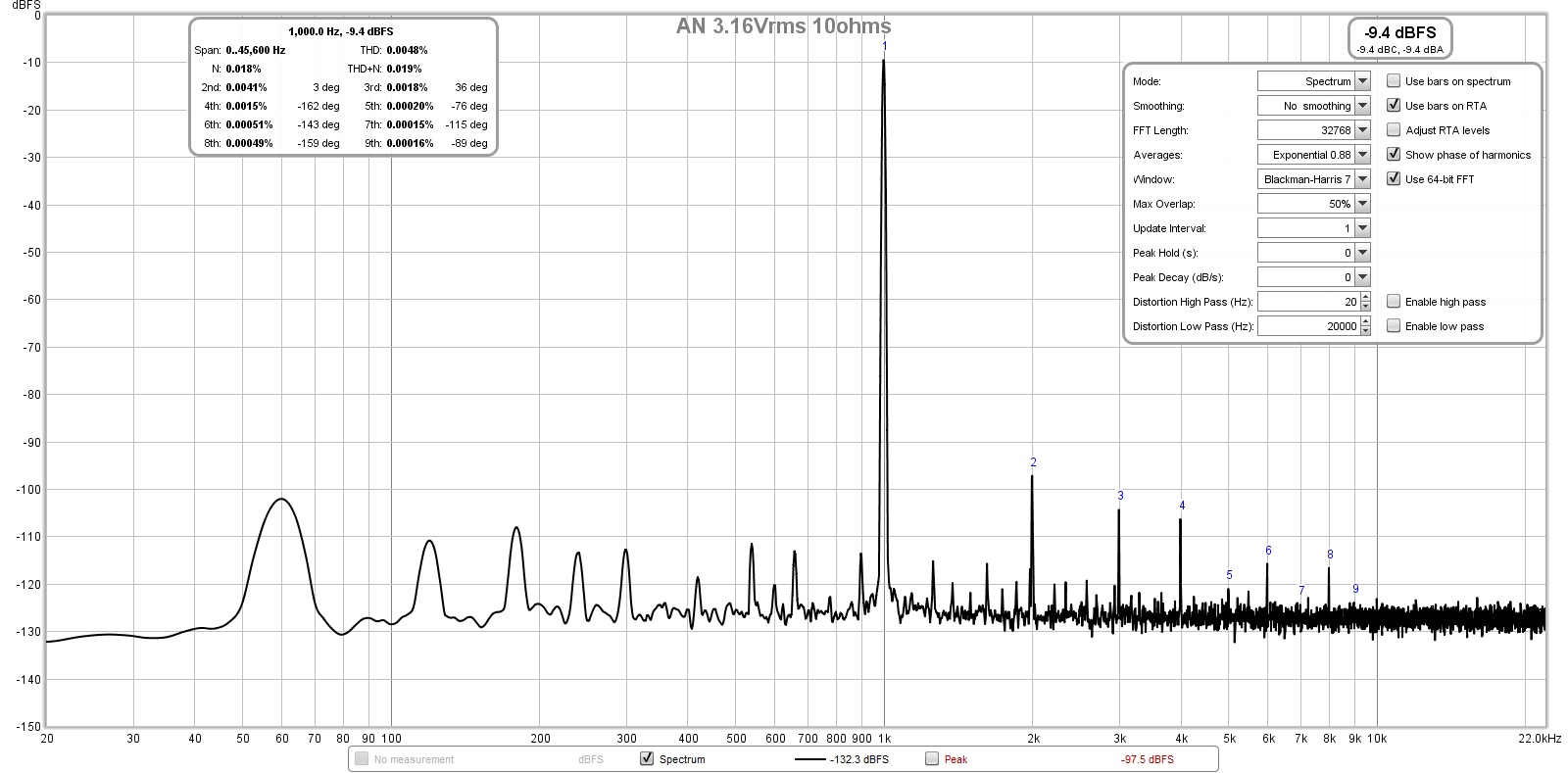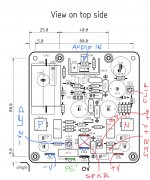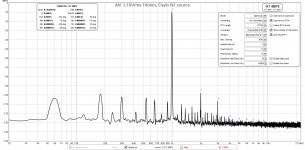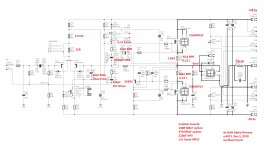Hi Maty,
With all the plating around the pcb for strength and thermal management, it should be high. BUT it would have to be measured with some very expensive gear I don't have, nor does X I think. It's an RFI field meter as I understand...
I know. The question was tricky because there are supposed to be only two levels, the commercial and the military. I suppose that in aerospace it will be the military maximum, that is, 90 dB. Maybe JPS can bring more light about ESA and NASA standards.
90 dB is a magic number in audio.
Last edited:
Ohmite Audio Gold 5W - 0,22 Ohm
Thank you Hugh.
Thanks to Danny , ISA-PBH a good tip,for sure exquisit, but bit pricey 🙁.
An other candidate could be Ohmite Audio Gold 5W - 0,22 Ohm :: Audio Gold 5W :: Ohmite :: Resistors :: Passive Components :: Electronic Parts :: Banzai Music GmbH for lesser money.
I am currently frickeling to finnish Mooly's Latmos Amp (...designed for music) with these resistors, without possibility for THD measuring.
So all doing on these by X is much appreciated to enlightening a bit more. 🙂
Thank you Hugh.
Thanks to Danny , ISA-PBH a good tip,for sure exquisit, but bit pricey 🙁.
An other candidate could be Ohmite Audio Gold 5W - 0,22 Ohm :: Audio Gold 5W :: Ohmite :: Resistors :: Passive Components :: Electronic Parts :: Banzai Music GmbH for lesser money.
I am currently frickeling to finnish Mooly's Latmos Amp (...designed for music) with these resistors, without possibility for THD measuring.
So all doing on these by X is much appreciated to enlightening a bit more. 🙂
It seems the KOA BPR series beat the Panasonic ERX, previously, what I considered the best. The KOA’s are reasonably priced and easy to find.
I think this is the one I'm going to build in a smaller chassis with some CPU cooler type heat-sinking. With those portable cards, it's seems like the perfect time to do some experimenting.... I have several projects in front of that, but I think you could do something very unorthadox and FUGLY! 🙂
Hi Bangla,
Those Ohmite Gold from Banzai music are inductive.
You need the non-inductive wound version named AG5NF
Those Ohmite Gold from Banzai music are inductive.
You need the non-inductive wound version named AG5NF
Hi X, just a quick question for you, is the power supply connection available on the AN pcb, the same as on the SSR protection pcb so that I can connect the DC power from the AN board directly to the 2 way Molex connector you supply with the SSR protection pcb?
I can't really see for sure in the photo's you have posted so far for the loaded AN pcb.
regards,
Gary..
I can't really see for sure in the photo's you have posted so far for the loaded AN pcb.
regards,
Gary..
Power supply into the amp and earth ground are Faston spades. Audio output is your choice Faston spades or 4pin Molex minifit same as on SSR unit (redundant wires).
Here is the stuffing diagram from production board marked up with where things go.

Here is the stuffing diagram from production board marked up with where things go.
Attachments
Last edited:
.... is the power supply connection available on the AN pcb, the same as on the SSR protection pcb so that I can connect the DC power from the AN board directly to the 2 way Molex connector you supply with the SSR protection pcb?
Hi Gary,
Yes, the AN uses the same Molex kk male 2-pin header as the SSR board for dc power. You will make a cable with the matching female connectors on both ends.
Thanks for clarifying that Vunce. The addition of that power Molex KK was a suggestion from a member here but I can’t remember who. Thank you, for the suggestion. It made connecting the SAR a snap.
I have ordered the PCB’s for the AN via the Group Buy, and look forward to the “build it” discussions there, but I have a somewhat technical question that belongs in this thread, I think.
How essential is it to have the SSR’s? I understand that it is good insurance against unexpected failures, but does the AN needs that more than any other SS amp? Does the AN have a bad turn-on tump, or some other issue, that makes the SSRs essential? It appears that the AN PCB could be used without SSR, so what is gained by the extra expense and complexity?
I might add that I’m a tube amp man, have not used a Solid State amplifier for over 20 years, so I may be naive about the necessities of speaker protection. Thanks for the re-education.
How essential is it to have the SSR’s? I understand that it is good insurance against unexpected failures, but does the AN needs that more than any other SS amp? Does the AN have a bad turn-on tump, or some other issue, that makes the SSRs essential? It appears that the AN PCB could be used without SSR, so what is gained by the extra expense and complexity?
I might add that I’m a tube amp man, have not used a Solid State amplifier for over 20 years, so I may be naive about the necessities of speaker protection. Thanks for the re-education.
Last edited:
I went without an SSR for years, and never had a problem except once on a new heaadphone amp +/-24v rails SE Class A. One of the bias diodes failed and dumped the full rail on my Sony MDR-V6 and all I heard was a pop and the channel was no more. I now have SSR's on my powerful headphone amps.
Once, after I got my SSR installed in the VHEX+ amp with +/-53v rails, I accidentally blew one rail due to a fusable link failure on the PSU, and the output went to 14vdc. Luckily, my 10F/RS225F had the SSR in place and all I heard was a mild pop. But probably even 14vdc on 100w speakers is ok for a short time as that's the same as peaks on 12wrms. These are only 82.5dB sensitive speakers so they can take a lot of power.
But you may have very sensitive speakers, say 100dB Klipsch Forte's for example, as Vunce has. I don't think it would like 14vdc.
The turn on pop is present without the SSR, it is tolerable on my speakers - probably an 8v or so pulse that lasts half a second. Most speakers can take that - it is just annoying.
So really depends on your speaker and your preferences. You can certainly build and operate without the SSR (or even use a cheap relay based unit from eBay for $6). But the sound quality on that probably won't be as good as the SSR, which has been shown to not affect the signal negatively at all.
Basically, it depends. Or, YMMV. 🙂
Once, after I got my SSR installed in the VHEX+ amp with +/-53v rails, I accidentally blew one rail due to a fusable link failure on the PSU, and the output went to 14vdc. Luckily, my 10F/RS225F had the SSR in place and all I heard was a mild pop. But probably even 14vdc on 100w speakers is ok for a short time as that's the same as peaks on 12wrms. These are only 82.5dB sensitive speakers so they can take a lot of power.
But you may have very sensitive speakers, say 100dB Klipsch Forte's for example, as Vunce has. I don't think it would like 14vdc.
The turn on pop is present without the SSR, it is tolerable on my speakers - probably an 8v or so pulse that lasts half a second. Most speakers can take that - it is just annoying.
So really depends on your speaker and your preferences. You can certainly build and operate without the SSR (or even use a cheap relay based unit from eBay for $6). But the sound quality on that probably won't be as good as the SSR, which has been shown to not affect the signal negatively at all.
Basically, it depends. Or, YMMV. 🙂
How about running the AN from a simple PSU (full bridge rectifier + 10mF cans on each rail) ? How good is the PSRR ?
Last edited:
Well, you probably would want to use at least the typical 25W Class A CRC PSU's like that for a Pass F5/F6 which typically are in the 120mV rms ripple for 1.25A bias. Typically 4x 22,000 uF per channel.
We could run a sim to see what the PSRR is, but it is probably better than a single rail, SE Class A.
So I just ran an LTSpice sim of this amp to check for PSRR. I am not sure if I did this right so maybe Hugh can correct me if I am wrong. I put the input to ground. I connected an AC voltage to the power rail and excited it with 1Vpp with an impedance similar to the PSU set at 0.15ohms. The output signal from the amp into 8ohms was 428uV pp. So that is a calculated -67dB PSRR - pretty good actually. Doesn't sound right though - so I will wait for Hugh to chime in. That as 1kHz.
Now let me set freq to 60Hz and see if it worse. Just ran it at 60Hz excitation and got 235uV pp for 1Vpp input to the rails -73dB PSRR.
But, if I set the impedance of the noise to zero - that is, what you measure on the rail as ripple in practice, then 1000mV ripple in the supply makes 177mV ripple in the output or only -15dB PSRR.
I tried smaller 353mV pp (125mV rms) I still get 63mV ripple output (a lot) or -15dB PSRR.
I may be doing this wrong because I am only adding the ripple to one rail. I think in PSU systems, the ripple in one rail may exist 180 deg out of phase in the other rail, in which case, they might cancel and this will be a lot better.
I would wait for Hugh to weigh in.
We could run a sim to see what the PSRR is, but it is probably better than a single rail, SE Class A.
So I just ran an LTSpice sim of this amp to check for PSRR. I am not sure if I did this right so maybe Hugh can correct me if I am wrong. I put the input to ground. I connected an AC voltage to the power rail and excited it with 1Vpp with an impedance similar to the PSU set at 0.15ohms. The output signal from the amp into 8ohms was 428uV pp. So that is a calculated -67dB PSRR - pretty good actually. Doesn't sound right though - so I will wait for Hugh to chime in. That as 1kHz.
Now let me set freq to 60Hz and see if it worse. Just ran it at 60Hz excitation and got 235uV pp for 1Vpp input to the rails -73dB PSRR.
But, if I set the impedance of the noise to zero - that is, what you measure on the rail as ripple in practice, then 1000mV ripple in the supply makes 177mV ripple in the output or only -15dB PSRR.
I tried smaller 353mV pp (125mV rms) I still get 63mV ripple output (a lot) or -15dB PSRR.
I may be doing this wrong because I am only adding the ripple to one rail. I think in PSU systems, the ripple in one rail may exist 180 deg out of phase in the other rail, in which case, they might cancel and this will be a lot better.
I would wait for Hugh to weigh in.
Last edited:
We could run a sim to see what the PSRR is, but it is probably better than a single rail, SE Class A.
Not necessarily....see this quote from Elliott's site on constant current source loaded single ended class A amps:
Actually, the idea that a Class-A amp draws a continuous steady current from the supply is true in one case only. A single ended amp using a current source as the collector load will draw a continuous steady current - but only if it uses a single supply. In the case of a dual supply, the same amp will draw a continuous current from one supply, and a varying current from the other. (My thanks to Geoff Moss for pointing this out - a detail that few published designs have ever mentioned !)
When using this amp for mid or high frequencies in a multi amp set up, a single rail supply and the appropriate output capacitor might be better.
Thanks Danny for enlightening again. 😀.
If you look to Ohmite Datasheet PDF "Audio Gold" only a note "noninductiv
version available".
Arrrgggh! because not seeing that.
By searching only parts connexion shows results.
So trusted by X measurements i agree his KOA BPR compromise.
For non compromise ISA PBH will kept in mind. 🙂
If you look to Ohmite Datasheet PDF "Audio Gold" only a note "noninductiv
version available".
Arrrgggh! because not seeing that.
By searching only parts connexion shows results.
So trusted by X measurements i agree his KOA BPR compromise.
For non compromise ISA PBH will kept in mind. 🙂
I reinstalled the KOA BPR resistors and changed my 1kHz oscillator from the built in DAC on the Focusrite to using my Cayin N3 DAP playing a high res flac file of a 1kHz tone. The Cayin has a nice AKM4490 DAC and OPA1622 output driver. The distortion went down as well as the harmonic profile looks better with just h2 and h3 and very little of anything else. I need to be more careful to use a good external reference osc next time. I also have an Akitika 2ppm osc but that seemed to pick up a lot of EMI noise as it is in a plastic box. Here is the new FFT with the Cayin N3. The THD is now 0.0041% for 3.16Vrms into 10ohm (1W).

For comparison, here was previous result with internal DAC on Focusrite:

Here is the schematic marked up with my components and measurements "AS-BUILT". The circuit is verified and sounds great. Vunce will share his thoughts soon but sounds like his first channel fired up uneventfully and has rock stable bias current and 0mV DC offset.

For comparison, here was previous result with internal DAC on Focusrite:
Here is the schematic marked up with my components and measurements "AS-BUILT". The circuit is verified and sounds great. Vunce will share his thoughts soon but sounds like his first channel fired up uneventfully and has rock stable bias current and 0mV DC offset.
Attachments
Last edited:
I previously had C1250 as 22pF silver mica, because that was all I had on hand. I recently pulled boards out and replaced with two 22pF NPO in series on the back of the board to get 11pF (closer to the 10pF spec'd by Hugh). It makes a discernable difference in the sound stage width and stereo imaging accuracy. I am listening to Ahmad Jamal's "Ahmad's Blues" album and the stereo imaging and sound stage are superb. Great engagement and dynamics. Pure listening pleasure. This amp is really a keeper. I will have to builld a proper 2mm thick, 2oz Cu, ENIG SLB power supply board for it with a nice built in star ground hub. (I am currently using the gen 1 prototype SLB with 1.6mm FRP, 1oz Cu, HASL, and only 2 GND pins). The wiring will get tidied up. Even get the expanding braided nylon sleeving with shrink tubing - the works. It will mean that my workhorse development chassis will be tied up. I will probably have to get another development chassis. Maybe a bigger 5U x 400mm this time? That will handle just about anything.
Last edited:
Yes X, that expandable nylon sleeving with heat shrink each end to tidy it up always looks a treat in the amp chassis. Comes in many sizes and is quite cheap on ebay as well.
I will use 10pF Silver Mica in the C1250 position as I will have to buy that in anyway. One of my jobs over Christmas is to sort out a "final to buy" Mouser list for these boards.
I will use 10pF Silver Mica in the C1250 position as I will have to buy that in anyway. One of my jobs over Christmas is to sort out a "final to buy" Mouser list for these boards.
- Home
- Amplifiers
- Solid State
- Alpha Nirvana 39w 8ohm Class A Amp


